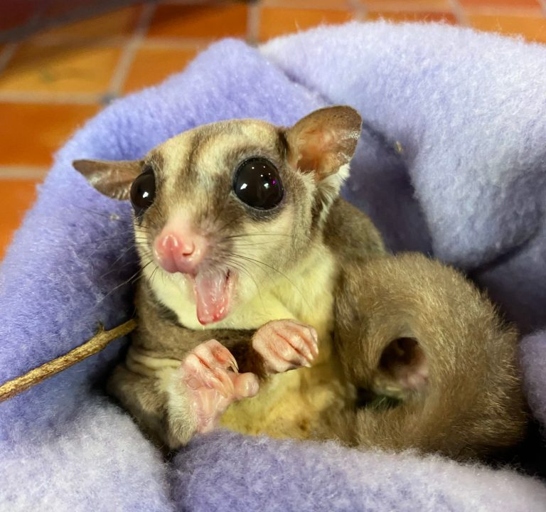Sugar gliders are small, nocturnal marsupials that are native to Australia, Indonesia, and New Guinea. They are popular pets in the United States, but sugar gliders can die if they are not properly cared for. There are three possible causes of death for sugar gliders: malnutrition, dehydration, and exposure to extreme temperatures.
1 – Improper Nutrition
A sugar glider‘s diet consists mainly of insects and nectar, which they eat in the wild. In captivity, they can be fed a diet of insects, fruits, and vegetables, but it is important to make sure that they are getting enough of the right nutrients.
One of the most common problems that can occur when sugar gliders are not properly nourished is malnourishment. Malnourishment can lead to a number of health problems, including weakness, hair loss, and even death. This can happen when they are not getting enough of the right nutrients, or when they are not getting enough food overall.

This can happen when they are eating too much of the wrong kinds of food, or when they are not getting enough exercise. Another common problem that can occur when sugar gliders are not properly nourished is obesity. Obesity can lead to a number of health problems, including heart disease, diabetes, and joint problems.
If you are concerned that your sugar glider may not be getting the proper nutrition, it is important to talk to your veterinarian. They can help you create a diet plan that will ensure that your sugar glider gets all of the nutrients they need.
2 – Getting Too Cold
Sugar gliders are very sensitive to temperature changes and can die from getting too cold. If you think your sugar glider is getting too cold, take them to a warm, safe place immediately and contact a veterinarian. Their normal body temperature is around 95 degrees Fahrenheit, so even a small drop in temperature can be fatal.
3 – Illness
There are many potential causes of death for sugar gliders, but three of the most common are illness, injury, and malnutrition.
Sugar gliders are susceptible to a variety of diseases and illnesses, both common and rare. Illness is a major cause of death for sugar gliders. Some of the most common illnesses that can kill sugar gliders are pneumonia, cancer, and heart disease. Sugar gliders can also die from less common illnesses, such as liver disease, kidney disease, and gastrointestinal disease.

Sugar gliders are very small and fragile, and even a minor injury can be fatal. Injury is another leading cause of death for sugar gliders. Common injuries that can kill sugar gliders include broken bones, head injuries, and spinal cord injuries.
Sugar gliders require a diet that is high in protein and fat, and low in sugar. Malnutrition is also a common cause of death for sugar gliders. If they do not get enough of the right nutrients, they can become malnourished and die.
Be Careful with Sugar Gliders
Sugar gliders are small, nocturnal marsupials that are native to Australia, Indonesia, and New Guinea. They are becoming increasingly popular as pets in the United States, but there are a few things potential owners should know before they decide to get one.
They are very active and need a lot of space to run and play. They also require a special diet of insects, fruits, and vegetables. If their diet is not balanced, they can become sick and even die. First, sugar gliders are not easy to care for.

This can lead to health problems and even shorten their life span. Second, sugar gliders are very social animals and need to be around other sugar gliders or they will become stressed and depressed.
Lastly, sugar gliders are nocturnal creatures and will be up and running around at night. This can be disruptive to their owners’ sleep schedules.
If you are considering getting a sugar glider, be sure to do your research and make sure you are prepared to provide them with the care they need.
Frequently Asked Questions
1. What are the three possible causes of death in sugar gliders?
2. How can I tell if my sugar glider is sick?
3. What are some common signs of illness in sugar gliders?
4. How can I prevent my sugar glider from getting sick?
5. What should I do if my sugar glider is sick?
6. How can I tell if my sugar glider is in pain?
7. What are some common signs of pain in sugar gliders?
8. How can I prevent my sugar glider from experiencing pain?
9. What should I do if my sugar glider is in pain?
10. What can I do to help my sugar glider live a long and healthy life?
1. What are the three possible causes of death in sugar gliders?
The three possible causes of death in sugar gliders are malnutrition, dehydration, and stress.
2. How can I tell if my sugar glider is sick?
You can tell if your sugar glider is sick if it is not eating or drinking, if it is not moving around, or if it is not making any noise.
3. What are some common signs of illness in sugar gliders?
Some common signs of illness in sugar gliders are weight loss, lethargy, and diarrhea.
4. How can I prevent my sugar glider from getting sick?
You can prevent your sugar glider from getting sick by feeding it a healthy diet, keeping it hydrated, and providing it with a clean and safe environment.
5. What should I do if my sugar glider is sick?
If your sugar glider is sick, you should take it to the vet to get it checked out.
6. How can I tell if my sugar glider is in pain?
You can tell if your sugar glider is in pain if it is crying or if it is not moving around.
7. What are some common signs of pain in sugar gliders?
Some common signs of pain in sugar gliders are crying, lethargy, and weight loss.
8. How can I prevent my sugar glider from experiencing pain?
You can prevent your sugar glider from experiencing pain by providing it with a clean and safe environment and by taking it to the vet if it is sick.
9. What should I do if my sugar glider is in pain?
If your sugar glider is in pain, you should take it to the vet to get it checked out.
10. What can I do to help my sugar glider live a long and healthy life?
You can help your sugar glider live a long and healthy life by feeding it a healthy diet, keeping it hydrated, and providing it with a clean and safe environment.
Final thoughts
Sugar gliders are a type of marsupial that is native to Australia. They are nocturnal animals that live in trees and eat mainly insects. Sugar gliders are popular pets, but they require special care.
Sugar gliders can die from a number of causes, including malnutrition, dehydration, and exposure to cold temperatures. Sugar gliders are also susceptible to a number of health problems, such as diabetes, cancer, and heart disease.
